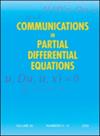spde的边界重整化
IF 1.7
2区 数学
Q1 MATHEMATICS
Communications in Partial Differential Equations
Pub Date : 2021-10-07
DOI:10.1080/03605302.2022.2109173
引用次数: 2
摘要
摘要我们考虑了连续抛物型Anderson模型(PAM)和具有边界条件的三维立方体上的动力学方程。虽然狄利克雷解理论是相对标准的,但Neumann/Robin边界条件的情况引起了发散边界的重新规范化。此外,得到了“边界平凡性”的结果:如果用Neumann边界条件和通常的整体重规范化近似方程,则极限过程与使用Dirichlet边界条件获得的极限过程一致。本文章由计算机程序翻译,如有差异,请以英文原文为准。
Boundary renormalisation of SPDEs
Abstract We consider the continuum parabolic Anderson model (PAM) and the dynamical equation on the 3-dimensional cube with boundary conditions. While the Dirichlet solution theories are relatively standard, the case of Neumann/Robin boundary conditions gives rise to a divergent boundary renormalisation. Furthermore for a ‘boundary triviality’ result is obtained: if one approximates the equation with Neumann boundary conditions and the usual bulk renormalisation, then the limiting process coincides with the one obtained using Dirichlet boundary conditions.
求助全文
通过发布文献求助,成功后即可免费获取论文全文。
去求助
来源期刊
CiteScore
3.60
自引率
0.00%
发文量
43
审稿时长
6-12 weeks
期刊介绍:
This journal aims to publish high quality papers concerning any theoretical aspect of partial differential equations, as well as its applications to other areas of mathematics. Suitability of any paper is at the discretion of the editors. We seek to present the most significant advances in this central field to a wide readership which includes researchers and graduate students in mathematics and the more mathematical aspects of physics and engineering.

 求助内容:
求助内容: 应助结果提醒方式:
应助结果提醒方式:


